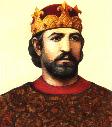
By finishing the war of liberation his brothers had started, Tsar Kaloyan, who ruled from 1197 to 1207, proved himself a deserved leader.
In the beginning, Tsar Kaloyan tended to avoid confrontation with Byzantium in order to subdue the splinter boyars and to strengthen his state against the boyars' opposition.
Unified, the Bulgarian army won a series of battles far south into Byzantine territories. Just five years after his ascension to the throne, Kaloyan had restored the one-time borders, and his state comprised today's northern Bulgaria, parts of Macedonia and Thrace and the regions of Belgrade and Branichevo.
In the spring of 1204, when Byzantium collapsed under the onslaught of the western knights of the Fourth Crusade, the young Bulgarian ruler was faced with a historic choice. Should he cross swords with the new Roman empire, just established on the former Byzantine territories, or should he choose the complexity of high diplomacy? He opted for the second, demonstrating sober political mind and good reason. Rather than clash with the empire, he sought union with the Pope. In 1204 a nuncio of Pope Innocent III crowned him King, and Kaloyan was presented with a scepter and a flag. Archbishop Vassily, the head of the Bulgarian church, was given the title of Primas.
However, Kaloyan preferred to style himself Emperor. Moreover, he was recognized as ruler not only of Bulgaria but of Vlachia, the lands north of the Danube, as well. Pope Innocent II himself wrote that "Kaloyan and his forerunners Peter and Assen have restored most of the country by right of their ancestors . The coronation amounted to a recognition of Bulgaria's independence, while ordinary Bulgarians maintained their Orthodox faith.
Kaloyan's diplomatic maneuvers temporarily averted the threat posed by the crusaders and strengthened the defence of the northwestern border where Catholic Hungarians still found it hard to put up with the loss of Belgrade and Branichevo. And most important of all, he gained time for preparation for the inevitable clash with the crusaders, already casting an eye on Thrace. He raised a strong army.
Meanwhile, negotiations were underway for an alliance with the Kumanians and the Seljuq Turks. The talks with Byzantine nobles provided further encouragement - Kaloyan was promised to be crowned in Constantinople as Byzantine Emperor in case he defeated the crusaders, an unprecedented promise in the history of Bulgarian-Byzantine relations.
Step by step Kaloyan was preparing for the victory that was finally won on 14 April 1205 near Adrianople. The Bulgarian shield clashed with the amour of the Latin knights, headed by Emperor Baldwin I Military historians have noted Kaloyan's skill in laying an ambush and, for the first time in Bulgarian history, the use ofreconnaissance in fight. They emphasize the excellent training of the Bulgarian troops and the perfect timing of the attack. The Bulgarian infantry and the Kumanian light cavalry routed the heavily armored knights, who had previously been considered invincible. "The cream of Latin chivalry was killed in that battle," wrote Robert de Claris. The emperor himself was captured and taken to Turnovo.
The battle of Adrianople, which revealed Kaloyan's exceptional talent as a military commander, echoed throughout Europe. The Latin empire was delivered a heavy blow and was to collapse several years later. In Rome the Pope had to give up his hopes of gaining control over the Eastern Orthodox Church. But it was not only fame Kaloyan fought for at Adrianople. His mind was focused on Bulgaria's survival next to the mighty Latin empire.
As a result of the victory Bulgaria became a force to be reckoned with. The fortresses of Seres, Skopje Ver and Muglen fell in succession. The following year the Bulgarians took Dimotica, Philipopolis, Cheraclea, Arcadiople and other strongholds. In the battle at Seres the Thessalonian King Bonifacius of Montferrat was killed. The Bulgarians controlled almost the whole of Thrace, and Kaloyan often cast an eye on the walls of Constantinople. However, he knew that without a fleet, a siege of Constantinople would result in an immense loss.

 My name is Radostina Georgieva, "Roddy".
My name is Radostina Georgieva, "Roddy".